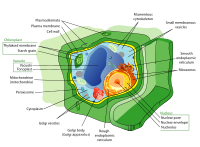
Photo from wikipedia
Abstract Mosses of the genus Sphagnum are the main components of peatlands, a major carbon-storing ecosystem. Changes in precipitation patterns are predicted to affect water relations in this ecosystem, but… Click to show full abstract
Abstract Mosses of the genus Sphagnum are the main components of peatlands, a major carbon-storing ecosystem. Changes in precipitation patterns are predicted to affect water relations in this ecosystem, but the effect of desiccation on the physiological and molecular processes in Sphagnum is still largely unexplored. Here we show that different Sphagnum species have differential physiological and molecular responses to desiccation but, surprisingly, this is not directly correlated with their position in relation to the water table. In addition, the expression of drought responsive genes is increased upon water withdrawal in all species. This increase in gene expression is accompanied by an increase in abscisic acid (ABA), supporting a role for ABA during desiccation responses in Sphagnum. Not only do ABA levels increase upon desiccation, but Sphagnum plants pre-treated with ABA display increased tolerance to desiccation, suggesting that ABA levels play a functional role in the response. In addition, many of the ABA signalling components are present in Sphagnum and we demonstrate, by complementation in Physcomitrium patens, that Sphagnum ABI3 is functionally conserved. The data presented here, therefore, support a conserved role for ABA in desiccation responses in Sphagnum.
Journal Title: Journal of Experimental Botany
Year Published: 2022
Link to full text (if available)
Share on Social Media: Sign Up to like & get
recommendations!